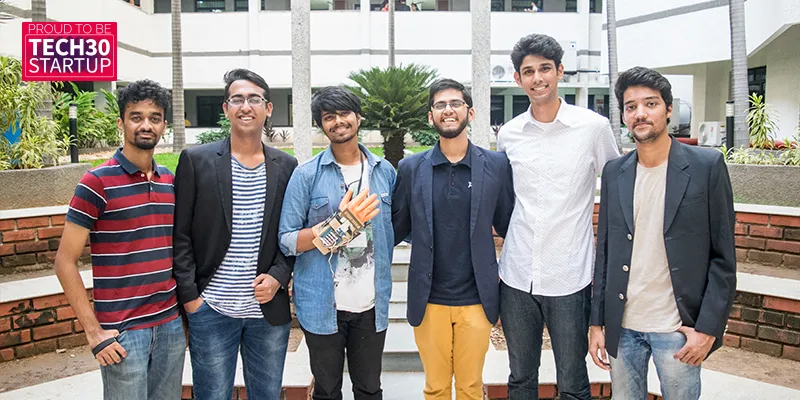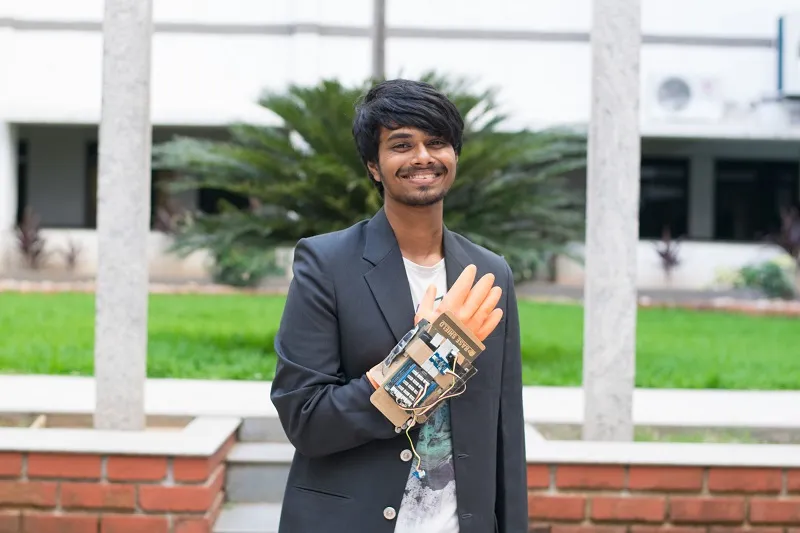Having raised Rs 20 lakh in college, Vicara aims to enter gesture recognition market with KAI
Here’s how getting disqualified at a hackathon inspired two college friends to enter the challenging hardware market and in the process raise Rs 20 lakh in equity-free funding.
Adarsh Warrier and Abhishek Satish were big fans of futuristic technology and superhero gadgets. While participating at an Intel Hackathon in Pune in August 2015, they thought to themselves,
Wouldn't it be cool, if we could control all kinds of technology like lights, robots and computers with a glove on our hand?
And that is how their startup journey with Vicara began. Let us trace their story from starting up in college to being a part of YourStory’s Tech 30 2017.

Vicara core team
Story so far
Over the 24-hour Intel hackathon, Adarsh and Abhishek created a basic prototype — a kitchen glove that could control lights and presentations on a PC. They later realised they were ineligible to participate because they didn't have PAN cards, which were mandatory for participation. When the results were declared, they found that the winner of the event had created a similar prototype that could control only lights. They had actually gone one step further by adding a PC integration.
While it was a demotivating moment, the two of them took inspiration from the fact that the idea they had worked on had potential. The duo was in their third year of engineering at VIT university during that time and the idea remained dormant for about six months.
Then they got an opportunity to pitch at a business plan competition, ‘StartupVIT’, and felt that it was a good stage to test the business potential of their project. They created a business plan to pitch the idea and were adjudged the runners up in that competition and won a prize money of Rs 30,000.
Abhishek and Adarsh then decided to reinvest that capital into developing the product and starting up. Both agreed that they would keep developing the product till they had the financial resources. Adarsh said,
Fortunately, we managed to move on to various grants, and prizes where we raised over Rs 20.3 lakh equity-free funds for our startup, Vicara. We were also the winners of the national Demo Day in Chennai in 2016. We were first among 94 participants in 12 cities to win a cash grant of Rs 5 lakh. The promise of our venture also helped us qualify for the NIDHI PRAYAS grant of Rs 10 lakh from IIT Bombay. Our university praised our efforts and made a contribution to it with a seed grant of Rs 5 lakh.”
Vicara was also selected among the top 500 ‘Future of technology’ startups around the world to attend the Global Summit and were also recently a part of YourStory’s Tech 30 2017 startups.
The founders were adamant that their company’s and product’s name should be of Indian origin; hence, they picked, "Vicara", which was derived from the Sanskrit word Vichar, which means idea or thought. Their product, KAI, means 'hand' in Tamil.
Manufacturing after 18 iterations over 12 months
In their journey so far, the team has seen a variety of ups and downs. A few of their early hurdles included managing academic work while still in college, fundraising for hardware resources and gaining credibility in a country where the hardware ecosystem isn’t as mature as the software ecosystem.
Adarsh said that over a period of 12 months, they have iterated their product, Kai, 18 times to arrive at the final prototype stage. Talking about manufacturing, Adarsh commented,
We had taken advantage of rapid in-house prototyping methods like 3D printing for development and we are currently in the user testing and feedback stage. We plan to proceed with lean manufacturing methods to optimise our cost and reduce wastage of resources. We are sourcing our parts from China and having the printed circuit board (PCB) manufactured locally in India. Our product is projected for launch in two months.
How KAI works and what it can do

A prototype version of KAI
KAI is a minimalistic wearable controller. It can recognise one’s hand gestures to interact with the digital world intuitively. It enables creative professionals and tech enthusiasts alike to interact with their digital environment. It aims to enhance productivity by creating a gesture-based computer interaction experience. Adarsh explained,
The product is essentially a sensor-based wearable that uses a nine axis Inertial Measurement Unit (IMU) and invisible light sensors to sense the movement of your hand and fingers. The data is relayed via a Bluetooth module to our proprietary desktop app UI designed on Sketch 3 and Principle. The instructions for the hardware have been coded in Embedded C on the ARM Cortex M architecture.
Vicara has filed a patent for the product in "methods of gesture recognition and contactless digit recognition for digital applications". Adarsh remarked that according to their understanding, Vicara is the first IMU-based gesture controller with contact-less finger recognition and the only interface device that is optimised for enhancing productivity for creative professionals among the competitors in the space.
The main use case of the product is to augment the capability of creative professionals to interact effectively with their digital environments. Adarsh explained,
A CAD designer can intuitively interact with his 3D models on SolidWorks or MAYA as if the models were actually in their hands.
Other use cases of the product involve interfacing and improving interaction with gaming, virtual training and simulation, robot and drone control, AR/VR.
Sector overview and future plans
A report by Technavio analysts forecasted that the global gesture recognition for mobile devices market is expected to grow to $6,647.46 million by 2021, at a CAGR of more than 61 percent over the forecast period.
Thalmic Labs is a prominent player in the wearable gesture control space, with their Myo armband which lets users take control of their phone, computer, and other devices touch-free. The venture had raised a $120 million Series B round in September 2016. Leap Motion, which recently raised a $50 million funding round led by J.P. Morgan Asset Management, and Oculus Touch, which is a product by Facebook owned Oculus Rift, are other noteworthy players in this space.
Vicara consists of a core team of six. Based out of the incubator in VIT University, they are also engaging a student intern team of 30. Adarsh said that they are set to launch their product on a crowdfunding platform in two months, and the plan is to sell at least 50,000 units over the next year. He remarked,
We also want to see the KAI being diversified into various sectors like music, gaming, robotics, AR/VR, simulation, and design.
The consumer version of the product will likely retail between $120 to $150. Simultaneously, the team is also approaching B2B consumers like Autodesk and Airbus, who it believes are the right target market for its product.
The product has a potential use case to be integrated with any Bluetooth-enabled device for digital or hardware interaction in the future. The potential applications of the wearable can revolutionise the way we play music, games, VR, AR and even the way we interact with drones and robots.
Vicara’s long-term vision is to set up a hardware ecosystem in India like that of the US and China.
Website- Vicara







